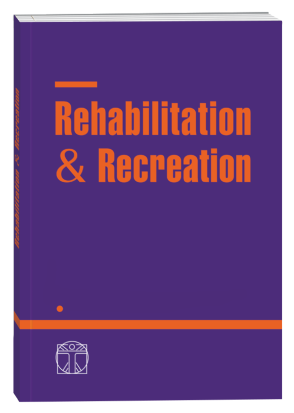RESTORATION OF FUNCTIONAL DISORDERS OF THE UPPER EXTREMITIES IN PATIENTS WITH RHEUMATOID ARTHRITIS AS A RESULT OF THE IMPLEMENTATION OF REHABILITATION TECHNOLOGY
DOI:
https://doi.org/10.32782/2522-1795.2023.17.6Keywords:
rheumatoid arthritis, functional disorders of the upper extremities, Boston questionnaire, technology of rehabilitation measures.Abstract
The purpose of the paper is to evaluate the effectiveness of the technology of rehabilitation measures for the restoration of functional disorders of the upper extremities in patients with rheumatoid arthritis. Materials and methods. A total of 188 patients with rheumatoid arthritis were examined, including 156 women (83%) and 32 men (17%), with an average age of 45 years. All patients were randomly assigned to the control (n = 92) and intervention (n = 96) groups. To determine the effectiveness of the technology of rehabilitation measures for the restoration of functional impairment of the upper extremities in patients with rheumatoid arthritis, we used the Boston Carpal Tunnel Questionnaire (BCTQ), consisting of two scales: the symptom severity scale and the functional impairment scale, which was filled out by patients independently. Results. According to the Symptom Severity Scale (SSS) of the Boston Questionnaire, patients with rheumatoid arthritis have pain in the affected upper extremities, numbness, tingling, decreased sensitivity, and muscle weakness. The Function Status Scale (FSS) revealed difficulties that patients had in performing daily activities and self-care (buttoning clothes, carrying bags of groceries, housework, bathing and putting on clothes, opening a bottle) and a decrease in physical activity. The analysis of the results of the BCTQ questionnaire on the scale of symptom severity after 3 and 6 months of rehabilitation measures showed better dynamics in patients of the main group compared to patients of the control group. The implemented technology of rehabilitation intervention for patients of the main group helped to reduce weakness and strengthen the muscles in the arm/wrist. After 6 months, 80.2% of respondents in the intervention group reported no weakness in the limbs, while in the control group the figure was much worse – 63.1% of people. When grabbing and using small things, improvement also occurred in both groups, but 80.2% of patients in the intervention group reported no difficulties, while in the control group, the number of such respondents was 65.2%. After 6 months, there was also a positive dynamic of restoration of physical activity in patients of both groups, which was confirmed by the results of the BCTQ questionnaire (functional impairment scale), but the results in patients of the main group were significantly better. Conclusion. The analysis of the results of the BCTQ questionnaire (according to the scale of symptom severity and functional impairment) revealed that 3 and 6 months after hospitalization and rehabilitation measures, patients with rheumatoid arthritis in the main group showed significant improvement, which confirms the effectiveness of the implemented technology of rehabilitation measures. Patients in the control group also showed positive changes in the questionnaire scores, but they were worse than those in the intervention group.
References
Гонт А.А., Зарудна О.І. Ревматоїдний артрит – історія, сучасні погляди, тактика, результат. Медсестринство. 2020. № 4. С. 30–36.
Григус І.М., Ногас А.О. Комплексний аналіз больового синдрому у пацієнтів на ревматоїдний артрит. Медичні перспективи. 2023. № 28 (1). С. 148–152. DOI: https://doi.org/10.26641/2307-0404.2023.1.276049.
Журавльова Л.В., Олійник М.О., Сікало Ю.К., Федоров В.О. Основи діагностики та лікування захворювань суглобів: навчальний посібник для лікарів. Київ: Видавничий дім «Медкнига», 2020. 272 с. ISBN 978-966-1597-78-4.
Коритко З.І., Поник Р.М., Купріненко О.В. Вплив засобів фізичної реабілітації на якість життя хворих при ревматоїдному артриті. Експериментальна та клінічна фізіологія і біохімія. 2019. № 4 (88). С. 45–52.
Міжнародна класифікація функціонування, обмеження життєдіяльності та здоров’я: МКФ. Всесвітня організація охорони здоров’я / пер. з англ. Київ, 2018. 1048 с.
Ревматоїдний артрит: адаптована клінічна настанова, заснована на доказах: Наказ МОЗ України від 11 квітня 2014 р. № 263
(2014). URL: www.moz.gov.ua.
Ногас А.О. Результати рентгенологічного дослідження та визначення індексу маси тіла у хворих на ревматоїдний артрит.
Art of Medicine. 2022. № 4 (24). С. 109–113. DOI: 10.21802/artm.2022.4.24.109.
Ногас А.О. Оцінка функціональних порушень верхніх кінцівок у хворих на ревматоїдний артрит. Український журнал медицини, біології та спорту. 2023. № 8 (1). С. 57–58.
Ногас А.О. Оцінка функції руки у пацієнтів із ревматоїдним артритом у результаті застосування фізичної терапії. Art of Medicine.
№ 2 (26). С. 98–103. DOI: 10.21802/ artm.2023.2.26.98.
Ногас А.О. Ефективність впливу реабілітаційних заходів на відновлення функції верхніх кінцівок у хворих на ревматоїдний артрит. Public Health Journal. 2023. № 3. С. 88–94. DOI: https://doi.org/10.32782/pub.health.2023.3.11.
Ногас А.О. Покращення якості життя хворих на ревматоїдний артрит за допомогою фізичної активності. Rehabilitation & recreation. 2022. № 13. С. 48–53. DOI: 10.32782/2522-1795.2022.13.6.
Перепада Г.В. Периферична нейропатія у хворих на ревматоїдний артрит. ScienceRise: Medical Science. 2019.1(28):24-31.
Півняк О.А., Неханевич О.Б. Проблеми фізичної терапії псоріатичних артропатій на фоні коморбідної патології. Український журнал медицини, біології та спорту. 2022. № 7:1 (35). С. 42–50.
Grygus I., Nogas A. Main provisions of the concept of physical therapy for patients with rheumatoid arthritis. Journal of Education, Health and Sport. 2020;10(3):340-351. http://dx.doi.org/10.12775/JEHS.2020.10.03.037
Levine, D.W., Simmons, B.P., Koris, M.J., Daltroy, L.H., Hohl, G.G., Fossel, A.H., Katz, J.N. A self-administered questionnaire for the assessment of severity of symptoms and functional status in carpal tunnel syndrome. J. Bone Joint Surg Am. 75(11). 1993. 1585–1592.
Pozmonova N., Bogdanovska N., Kalonova I., Boichenko C., Bessarabova O. Effect of occupational therapy intervention in a comprehensive rehabilitation program on patients with early rheumatoid arthritis. Journal of Physical Education and Sport. 2021. № 10. Р. 3024–3029. DOI: 10.7752/jpes.2021.s5402.
Salaffi F., Di Carlo M., Carotti M., Sarzi-Puttini P. The effect of neuropathic pain symptoms on remission in patients with early rheumatoid arthritis. Curr Rheumatol Rev. 2019. № 15. Р. 154–161.
Wafaa Mahmoud, Mona Mansour Hassab El‑Naby and Ahmed Abdellatif Awad. Carpal tunnel syndrome in rheumatoid arthritis patients: the role of combined ultrasonographic and electrophysiological assessment. Egyptian Rheumatology and Rehabilitation. 2022. № 49. С. 62. DOI: https://doi.org/10.1186/s43166-022-00147-9.
Downloads
Published
How to Cite
Issue
Section
License

This work is licensed under a Creative Commons Attribution-NonCommercial-NoDerivatives 4.0 International License.











